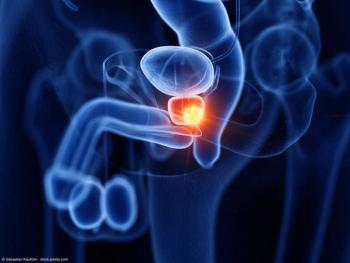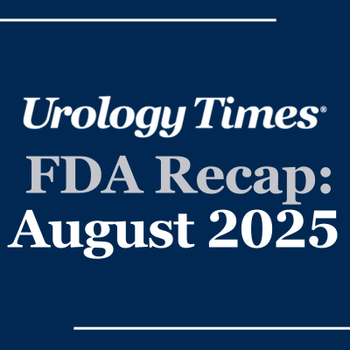
Evaluating detection rate of 18F-rhPSMA-7.3 PET in patients with suspected recurrence of prostate cancer
Lead author David M. Schuster, MD, FACR, assessed the detection rate of the novel theranostic PET ligand in a population of almost 400 men and found that the data supported clinical utility of 18F-rhPSMA-7.3 PET in managing men with recurrent prostate cancer across a wide range of prostate-specific antigen levels.
In a recent multicenter study, a team of investigators determined the efficacy of radioligand 18F-rhPSMA-7.3 PET in detecting prostate cancer among patients who are suspected of recurrence.1
Lead author David M. Schuster, MD, FACR, assessed the detection rate of the novel theranostic PET ligand in a population of almost 400 men and found that the data supported clinical utility of 18F-rhPSMA-7.3 PET in managing men with recurrent prostate cancer across a wide range of prostate-specific antigen (PSA) levels. He explains what these results mean in the following interview. Schuster is a professor of radiology and imaging sciences and urology, a GRA distinguished cancer scientist, and the director of the division of nuclear medicine and molecular imaging at the Emory University School of Medicine in Atlanta, Georgia.
Please discuss the background for this study.
This study is designed to evaluate a very interesting radiopharmaceutical: 18F-rhPSMA-7.3. This is a radio hybrid platform, in which one can switch out the radionuclide. It's based on [prostate-specific membrane antigen], and one can have, for example, a hot fluorine and cold gallium or hot Lu177 or Ac225 and cold fluorine and use it for therapy, making it a true theranostic. [The] study itself is a multicenter, [prospective] trial in the biochemical recurrence setting, looking at the diagnostic performance of the rhPSMA-7.3 PET in this setting.
What were the notable findings of this study? Were any of them surprising to you or your co-authors?
I think the notable finding is the fact that the overall detection rate is very high, even at low PSA levels. This is, for example, at a PSA of less than 0.5. The overall detection rate is 64%, and this goes up to 93% with a PSA between 1 and 2, and then 100% with high PSAs. So, that's number one. Number two, [which is,] I would say the most surprising, was the results themselves on the patient level. I read every single study that we did here at Emory. We did about 40 in the biochemical recurrence setting and 10 in the primary setting. Use in the primary setting is part of a separate Phase 3 trial. We really made a difference in many of these patients. We found lesions that I just did not believe we found until we got confirmatory biopsy or advanced imaging, which correlated with it. So, I'd say that's probably one of the more surprising points of this. Also, this study was opened during the worst days of COVID-19, and it actually accrued very quickly. That was a very pleasant surprise as well.
How will these findings affect the way that you treat prostate cancer in the future?
Knowing that we have better tools now, I would say that you don't really want to rely on conventional imaging in most situations. And if you really want to stage the patient appropriately, one should get the most advanced molecular imaging possible. There [are] many ways of doing this, and I think that rhPSMA-7.3, hopefully, will be added to the armamentarium. It has a lot of promise both in the radio hybrid level, as well as the potential to have less urinary excretion, which is important for prostate cancer imaging.
Is there further research on this topic planned? If so, what will its focus be?
I think that there'll be many, many spinoffs. First of all, the data itself is extremely deep, so there'll be many, many sub analyses from the data [and] it won't stop with the coprimary end points. There is a sister trial, called LIGHTHOUSE, which is in high-risk primary prostate cancer patients. That was a little more delayed, but it [was] fully accrued as well and they're analyzing the data now. So, that will be another study from this. I think there will be others, potentially. One might be how to best capitalize on the potential for low urinary excretion. There also may be sub populations, which may be studied in the future. But I think right now, just analyzing this very large multicenter study will keep everyone busy for a while.
What is the take-home message for the practicing urologist?
The take-home message is if one really wants to stage the patient appropriately, knowing what we're dealing with, and then be able to make an informed discussion with the patient, a radiotracer such as rhPSMA-7.3 is ideal to help discover what usually cannot be seen with conventional imaging.
Is there anything else you feel our audience should know about this topic?
I think that we keep getting better and better tools, and I think understanding how to utilize these tools will be a challenge in the future. One area that is very promising is that this can be a therapeutic as well. You might say [it is] like putting different wheels or tires on your car to go off road or in the winter, for example. So, I think that is another promising area using this radiopharmaceutical as a scaffold [and] doing a true theranostic, [where we're] using the exact same molecule and swapping out the radioactive element.
Reference
1. Schuster DM. Detection rates of 18F-rhPSMA-7.3 PET in patients with suspected prostate cancer recurrence: results from a phase 3, prospective, multicenter study (SPOTLIGHT). Paper presented at: 2022 ASCO Genitourinary Cancers Symposium; February 17-19, 2022; San Francisco, California. Abstract #9
Newsletter
Stay current with the latest urology news and practice-changing insights — sign up now for the essential updates every urologist needs.


















